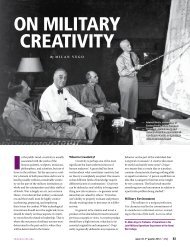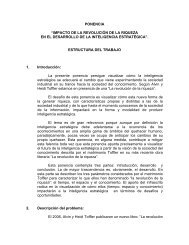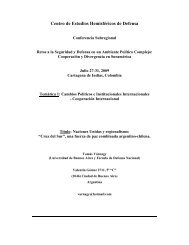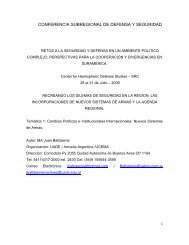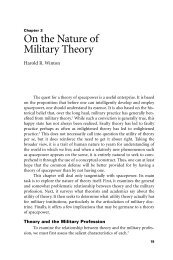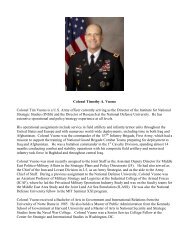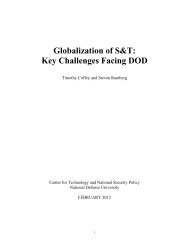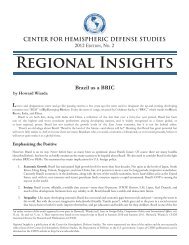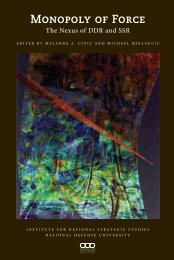The Expanded Nontraditional Role of the AFP - National Defense ...
The Expanded Nontraditional Role of the AFP - National Defense ...
The Expanded Nontraditional Role of the AFP - National Defense ...
You also want an ePaper? Increase the reach of your titles
YUMPU automatically turns print PDFs into web optimized ePapers that Google loves.
and development strategy <strong>of</strong> <strong>the</strong> <strong>AFP</strong>, which<br />
resulted in significant results for <strong>the</strong> counterinsurgency<br />
campaign. <strong>The</strong> government aimed<br />
to decisively defeat <strong>the</strong> communist insurgency<br />
using <strong>the</strong> triad concept <strong>of</strong> civil military operations,<br />
combat operations, and intelligence operations.<br />
<strong>The</strong> plan was so successful that it cleared<br />
13,000 affected communities between 1988 and<br />
1994, but it encountered problems with <strong>the</strong> economic<br />
development phase. 6<br />
<strong>The</strong> o<strong>the</strong>r extreme <strong>of</strong> <strong>the</strong> transformed<br />
nontraditional role continued throughout<br />
<strong>the</strong> Aquino administration. Military rebels<br />
led by Colonel Gregorio Honasan launched a<br />
series <strong>of</strong> attempted power grabs between 1986<br />
and 1989 that all failed. Accusing Aquino <strong>of</strong><br />
being too friendly with <strong>the</strong> Left, Honasan and<br />
his cohorts aimed to form a ruling civilianmilitary<br />
junta wherein <strong>the</strong> military would<br />
play a major role.<br />
<strong>The</strong> administration <strong>of</strong> Fidel Ramos took<br />
over from <strong>the</strong> Aquino regime in 1992 and<br />
immediately sought to make peace with any<br />
insurgent group that was receptive to <strong>the</strong><br />
<strong>of</strong>fer. Ramos, a graduate <strong>of</strong> <strong>the</strong> U.S. Military<br />
Academy at West Point, was a former general<br />
and defense chief who understood <strong>the</strong> importance<br />
<strong>of</strong> achieving strategic peace before any<br />
meaningful political stability and economic<br />
progress could take place. As chief <strong>of</strong> <strong>the</strong><br />
Philippine constabulary for 14 years, Ramos<br />
understood <strong>the</strong> effectiveness <strong>of</strong> security and<br />
development toward achieving <strong>the</strong> goals <strong>of</strong> his<br />
administration. If Aquino’s watch was plagued<br />
by one coup attempt after ano<strong>the</strong>r, <strong>the</strong> Ramos<br />
presidency experienced no such threat.<br />
Ramos made strategic peace with military<br />
rebels in 1992, appealing to <strong>the</strong>m instead<br />
to positively affect Philippine development<br />
through nonviolent means. As a result, Letter<br />
<strong>of</strong> Instruction 42/94, “Unlad-Bayan,” was<br />
<strong>Role</strong> <strong>of</strong> <strong>the</strong> afP<br />
launched. This letter was <strong>the</strong> campaign plan<br />
for <strong>the</strong> development or nation-building role <strong>of</strong><br />
<strong>the</strong> <strong>AFP</strong>. It sought to rectify where “Lambat-<br />
Bitag” had failed. Specifically, <strong>the</strong> plan advocated<br />
<strong>the</strong> lead agency concept, involvement<br />
<strong>of</strong> civic and sectoral organizations and military<br />
commanders at all levels, delivery <strong>of</strong><br />
basic services, <strong>AFP</strong> economic development<br />
projects (livelihood projects), cooperative<br />
development, disaster preparedness, use <strong>of</strong><br />
reservists, <strong>AFP</strong> modernization (anchored on<br />
self-reliance), and environmental protection<br />
and preservation. 7 <strong>The</strong> Army Concern on<br />
Community Organizing for Development, for<br />
instance, was in line with <strong>the</strong> implementation<br />
<strong>of</strong> “Unlad-Bayan.”<br />
After attaining peace with <strong>the</strong> military<br />
rebels, Ramos next made peace with <strong>the</strong><br />
MNLF, led by Nur Misuari, in 1996. Although<br />
it appeared as if Ramos was making peace<br />
with <strong>the</strong> enemies <strong>of</strong> <strong>the</strong> state one by one,<br />
<strong>the</strong> fact was that governmental peace overtures<br />
were <strong>of</strong>fered to various insurgent groups<br />
almost simultaneously. Even while meaningful<br />
progress had already been achieved with <strong>the</strong><br />
military rebels and MNLF, <strong>the</strong>re were likewise<br />
ongoing peace talks with <strong>the</strong> CPP/NPA and<br />
MILF. In fact, inroads toward achieving a similar<br />
peace accord as that sealed with <strong>the</strong> MNLF<br />
were already in <strong>the</strong> works when <strong>the</strong> Ramos<br />
administration had to put everything on hold<br />
as it turned over power to Joseph Estrada, who<br />
succeeded Ramos in 1998.<br />
Ramos took advantage <strong>of</strong> <strong>the</strong> generally progressive<br />
political and economic atmosphere by<br />
issuing a change in approach. 8 He hoped to turn<br />
<strong>the</strong> counterinsurgency over to <strong>the</strong> Philippine<br />
<strong>National</strong> Police, thus allowing <strong>the</strong> <strong>AFP</strong> to focus<br />
on modernizing itself in order to become capable<br />
<strong>of</strong> deterring external aggression after decades<br />
<strong>of</strong> addressing internal rebellion.<br />
PRISM 3, no. 2 FeatuReS | 103



